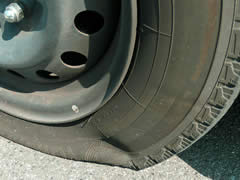Quick DIY Repairs to Tire Puncture - Vol.256
Experiencing a puncture, especially on a new tire, is an awful feeling. The cost of replacements is sky high and the issue is not your fault, which makes the cost even harder to bear.
Luckily there are a number of DIY fixes that you can apply to a tire with a puncture, assuming you apply them quickly and don't continue to use the tire after first discovering the puncture until you have made the fix. Furthermore, these options tends not to be workable for the sidewall of the tire so only use them if you have noticed a puncture in the main tread.

Plugs
Tire plugs are rather mysterious things. They simply don't look like they would work but, when implemented correctly, they can do a spectacular jobs when it comes to plugging up a puncture and protecting your tires from further damage.
Tire plugs are cheap to buy and, though they shouldn't be used as a permanent repair option they are certainly good enough to last a short while before you can get the car to the shop and have the tire fully repaired.
It is important to note that, as mentioned previously, you should never attempt to use a plug on a puncture that is in the sidewall of the tire. It simply doesn't work and the increased pressure can cause a blowout if you're particularly unlucky.
With that being said, the steps for installing a plug are pretty simple:
- Find the offending object that has penetrated the tire, such as a nail, and mark the spot where the plug will need to be placed with a piece of tape so that you can see it when you remove the object.
- Use pliers to remove it slowly and carefully so as not to cause any more damage.
- If you have purchased a tire plug kit it should come with a tool called a reamer, which looks like a large file. Use it in the puncture to clean out the hole and rough up the edges prior to installing the plug.
- Place the plug onto the insertion tool and insert it into the tire. Once you have threaded the plug in a little you will begin to meet resistance so make sure you push it in until only about a half inch of the plug remains on the outside. Once in, you simply need to remove the plugging tool and trim the parts of the plug that are on the outside of the tire and voila! Now all you need to do is fill the tire to the proper pressure and you're good to go.
Patches
Patches are an alternative method of fixing a punctured tire and are generally much more useful when the puncture is near the sidewall of the tire. This is because plugs generally just won't be able to seal all of the damage, which will lead to the tire slowly leaking air. Furthermore patches are also recommended for diagonal are bent holes that a plug simply can't be inserted into.
Patches are very simply to apply and many people recommend using them with a plug to provide the most complete solution. They work by simply sealing the entire puncture under the patch, without actually filling the hole that was made by whatever caused the puncture.
When push comes to shove both solutions can work well for most varieties of small puncture. However it must be said that the larger the puncture the lower the likelihood that one of these solutions will be adequate. Generally speaking a puncture that is above a quarter of an inch will require a replacement rather than a DIY repair.